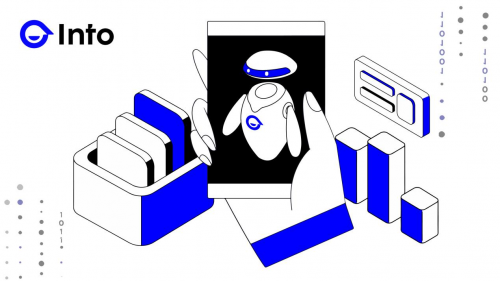INTO Web3, Reshaping Digital Identity Authentication
In the wave of the digital age, identity authentication has become the cornerstone for every individual to participate in the digital world. However, the current identity authentication system has many pain points: data silos, privacy leaks, identity fraud... These problems not only hinder the development of the digital economy, but also bring huge security risks to individuals digital lives. On this challenging track, INTO, as an open, free, efficient, secure and compatible Web3 social protocol, is reshaping the global paradigm of digital identity authentication with its unique technical advantages. In particular, INTOs multi-chain parallel wallet, SBT and other technologies provide global users with a safe, trustworthy and efficient identity verification and management platform.

Reshaping the digital identity authentication system
Digital identity authentication, as the infrastructure of the digital economy era, its importance is self-evident. However, the current identity authentication system faces many challenges, which seriously restricts the development of the digital economy. Among them, the three most prominent pain points can be summarized as the triple dilemmas: privacy is difficult to protect, fraud is difficult to prevent, and mutual trust is difficult to build.
First of all, in terms of privacy protection, most current identity authentication systems adopt a centralized data storage model. This means that massive amounts of identity data are concentrated in the hands of a few centralized institutions. This not only brings huge hidden dangers to data security, but also poses severe challenges to personal privacy protection. Problems such as data leakage and data abuse are common, and personal privacy faces the risk of streaking.
Secondly, in terms of identity authenticity, the current identity authentication system cannot effectively prevent identity fraud. Due to the lack of an effective identity verification mechanism, fake identities and false information are rampant. This not only disrupts the order of the digital world, but also brings huge risks to economic and social activities. Problems such as counterfeiting, fraud and information fraud are becoming increasingly serious and have become major hidden dangers for the healthy development of the digital economy.
Finally, in terms of mutual recognition of identities, the current identity authentication system presents a serious island effect. It is difficult to communicate and share identity information between different institutions and platforms, resulting in low efficiency of identity authentication and poor user experience. This fragmented state not only greatly increases the cost of identity management, but also hinders the coordinated development of the digital economy.
It is against this background that INTO came into being. INTO realizes that in order to solve the trilemma of digital identity authentication, fundamental innovation must be made in the system architecture. Blockchain technology, with its features such as decentralization, non-tamperability, and traceability, provides a perfect technical foundation for this innovation.

INTO’s new paradigm of identity authentication
The new identity authentication paradigm built by INTO can be summarized as “one core and two major features”. Its core is the multi-chain parallel wallet technology based on the blockchain; its two major features are the organic unity of identity security and identity value.
Let’s talk about core technology first. INTOs identity authentication system is based on the disruptive technology of blockchain. Blockchain, with its decentralized, non-tamperable, traceable and other characteristics, provides an ideal technical foundation for the secure storage and trusted circulation of identity data. The originality of INTO lies in its revolutionary solution of multi-chain parallel wallet.
What is a multi-chain parallel wallet? To put it simply, an identity aggregation wallet is generated for each user in multiple blockchain networks. This wallet can not only safely store identity data, but also achieve cross-chain identity mapping and cross-chain data synchronization. This means that users can use the same identity and enjoy consistent services in different blockchain networks. This one authentication, common to the whole chain mechanism has completely opened up the data island of identity authentication and realized a true global pass.
Let’s talk about the two major characteristics, namely identity security and identity value. Through multi-chain parallel wallets, INTO achieves distributed storage, encryption protection and autonomous management of identity data. Each user has full control over his or her identity data and can independently decide on the authorization and sharing of data. At the same time, the multi-chain architecture also greatly reduces the risk of single points of failure and data leakage. In addition, INTO has innovatively introduced zero-knowledge proof technology based on privacy computing to ensure data privacy while achieving trusted verification of identity authenticity. This series of technological innovations jointly build a solid line of identity security defense.
Identity value is mainly reflected in SBT. Through SBT technology, INTO deeply binds identity to individual digital behavior, contribution, and reputation, making identity the carrier and credential of personal value. In the INTO ecosystem, each identity is a value index that dynamically records all aspects of an individual in the digital world. This mechanism of shaping identity with behavior not only makes identity more three-dimensional and full, but also allows personal value to be fully reflected and reasonably rewarded.
In general, the new identity authentication paradigm built by INTO takes multi-chain parallel wallets as the core and identity security and identity value as the two wings to build a safe, trustworthy, efficient, and value-oriented digital identity ecosystem. The proposal and practice of this paradigm not only completely subverts the traditional centralized identity authentication logic, but also points out a new direction for the development of digital identity.

INTO drives innovation in digital identity authentication
INTO promotes the innovation of digital identity authentication paradigm, which can be summarized as a four-step strategy: the protocol layer builds the cornerstone of trust, the technology layer creates a security line of defense, the application layer activates identity value, and the ecological layer builds a development platform. This four-step strategy, interconnected and progressive, together constitutes the complete layout of INTO identity authentication.
The first step is to build the foundation of trust at the protocol layer. As an open identity authentication protocol, INTOs first priority is to build trust in the digital world. To this end, INTO has developed a complete set of identity authentication standards and specifications, clarifying the basic requirements and processes for identity generation, verification, and management. This set of standards can not only ensure the standardization and orderliness of the identity authentication process, but also provide a basis for mutual recognition of identities between different institutions and platforms. At the same time, INTO also makes full use of the consensus mechanism of the blockchain to make the identity authentication process open and transparent and subject to the supervision of the entire network. This approach of “building trust with code” has laid a solid foundation of trust for the INTO identity authentication system.
The second step is to build a security line of defense at the technical layer. INTO understands that without security there is no trust. Therefore, INTO strives to build a solid security line at the technical level. Among them, the most core one is the multi-chain parallel wallet technology. By storing identity data distributedly in multiple blockchain networks, and performing encryption protection and permission control, INTO achieves all-round protection of data privacy and security. At the same time, INTO has also innovatively introduced cutting-edge privacy computing technologies such as zero-knowledge proof and homomorphic encryption to achieve trusted verification of identity authenticity while protecting privacy.
The third step is to activate the identity value at the application layer. INTO firmly believes that the value of identity should not be limited to the identity itself, but should be reflected in the empowerment of people. Therefore, INTO continues to innovate at the application level to activate identity value. Among them, the most representative one is SBT technology. Through SBT, INTO deeply binds identity to an individuals behavior, contribution, and reputation in the digital world, making identity a dynamic value index. This not only makes the identity more three-dimensional and full, but also allows personal value to be fully reflected and reasonably rewarded. At the same time, INTO is also actively exploring the authorized sharing model of identity data, allowing users to safely and conveniently apply identity data to various scenarios to realize the multi-dimensional release of identity value. In addition, INTO is also planning to focus on creating new value-added services for identity data, and continue to expand the application boundaries of identity data through data analysis, credit evaluation and other means to create more value for users.
The fourth step is to build a development platform at the ecological level. INTOs ultimate vision is to build an open and prosperous digital identity ecosystem. To this end, INTO continues to make efforts at the ecological level to build a development platform for identity authentication. On the one hand, INTO actively promotes industry collaboration and widely connects various entities such as certification agencies, data sources, and application scenarios to create an identity authentication industry chain. On the other hand, INTO also opens up platform capabilities, provides identity authentication APIs, SDKs and other development tools, and encourages more developers to participate in ecological construction. At the same time, INTO also continues to explore the value path of identity data, and encourages all parties to jointly maintain and develop the identity data ecosystem through the design of mechanisms such as data rights confirmation and data transactions.
Through the organic combination and coordinated advancement of the four-step strategy, INTO is steadily promoting the innovation of the digital identity authentication paradigm. This innovation not only completely reshapes the technical architecture and trust logic of identity authentication, but also opens up a broad space for the full release of identity value. It is foreseeable that under the leadership of INTO, digital identity will usher in a new era of security, trustworthiness, efficiency and value-oriented.


